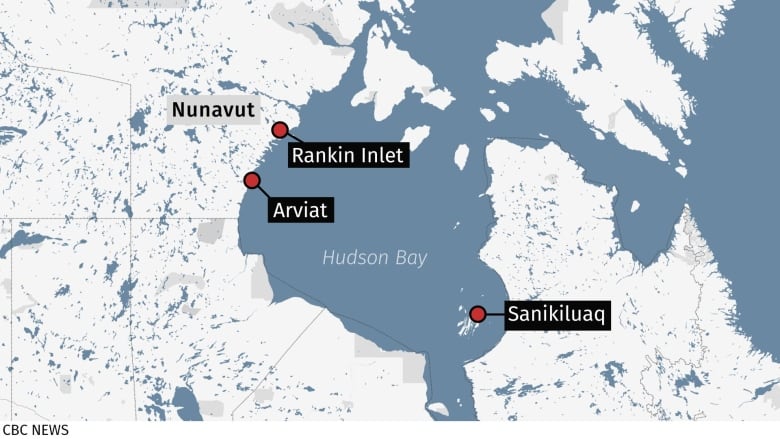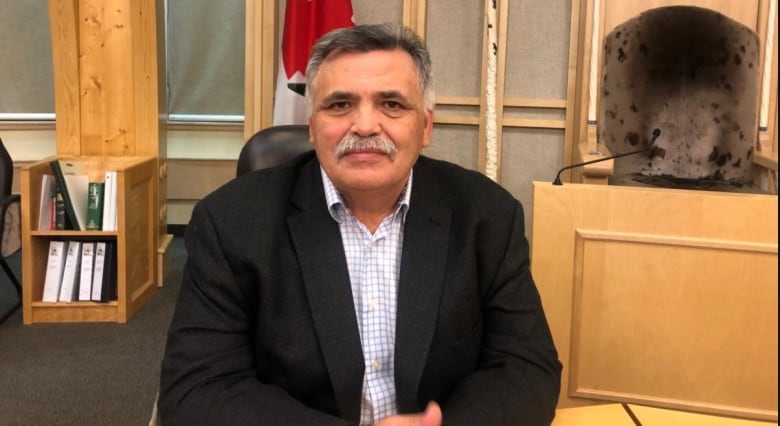Nunavut reaches 70 cases as recent outbreak continues to surge
Nunavut premier announced 10 more cases Wednesday

Nunavut Premier Joe Savikataaq called on residents to "plank these numbers and do what we need to do" as the territory reached 70 cases of COVID-19 and began a two-week lockdown on Wednesday.
"Our rise in cases over the past few days is significant, and seems scary," Savikataaq said, but "we did know they would rise once it is in the territory."
"This is it, folks it's time to take a stand and fight against COVID-19."
The update came during a news conference after a major surge in coronavirus cases this week. Eight of the new cases have been identified in Arviat, bringing the community's number of positive cases to 54. The other two cases are in Rankin Inlet, where the community's number of positive cases is now six.

All individuals are in isolation in their own homes and doing well, according to Chief Public Health Officer Dr. Michael Patterson.
Some health-care workers have also been asked to self-isolate, Patterson saidduring the news conference.
"In Arviat, it's too soon to say if we've stopped community transmission at this point," he said.
"In other communities things are more stable and we're certainly closer to having it stabilized and contained."
Missed the government update? Watch it here:
Patterson, who called on Nunavummiut to co-operate with contact tracers as they try to find who may be at risk of spreading or coming in contact with the disease, said his team has found no particular superspreader type events at this point which could have led to the large number of cases.
Clarity on lockdown rules
Patterson also cleared up some confusion around the rules for Nunavut's two-week lockdown order.
Outdoor gatherings are restricted to five people.
Indoor gatherings are also legally restricted to five people in addition to the people living in the household, but Patterson urged people not to visit, or gather unnecessarily.
Patterson said that while masks are only mandatory incommunities with active COVID-19 cases, businesses anywhere in the territory canmandate masks for their staff and patrons.
Non-essential work, however, muststop."In essence, if you closed back in March you must close again."
Last week Patterson said that child-carefacilities could stay open, to help critical staff do their jobs, but he clarified that this is "not an order" and that child-care providers are free to shut down if they wish.
Patterson added that he hopesthe centreswill stay open so essential workers have a place to send their children.
During the livestream of the news conference, several audience members suggested to CBC News that people whoisolatein southern cities should be tested for COVID-19 when they return into the territory.
CBCNews asked Patterson if that was on the table.
"There's a lot of debate and uncertainty about how and whether or not to augment isolation with testing," he replied. "Other jurisdictions [that]have added testing into their isolation have also seen cases arrive."
Patterson said it would take a lot of work to "build capacity in the South to do that testing."
Military intervention a last resort, health minister says
Because Nunavuthas less well-resourced medical careand zero intensive care units, the lockdown is the best way to manage capacity, Patterson said.
The Kivalliq Health Centre in Rankin Inlethas six beds. It will be up to the doctor thereto decide if someone in the region needs more serious care, Patterson said. "If anybody is in [a] situation where they need ongoing fluid, oxygen, or life support, they obviously can't stay in a health centre and will need to go to a southern hospital."
Traditionally, people in theKivalliq regiongo south to Manitoba for specialized care. But that province is now struggling with its own explosion of COVID-19.
Patterson said if the hospitals that Nunavummiut usually go to are full, the Health Departmentwill look at other hospitals it workswith less often.

Territorial Health Minister Lorne Kusugak said that in a recent meeting, the federal government offered to support the territory.
"We don't want to have to go there, but if there was a need in fact for the military to come and give us that support, they would be able to go to that extent," he said.
Quick jump in numbers
On Tuesday, the territory's COVID-19 caseload more than doubled from the previous day, reaching a high of 60 cases.
The majority of those cases are in Arviat. The hamlet, located on the western shore of Hudson Bay,is home to more than 2,500 people.
Another eight cases were identified in Whale Cove, which has a population of about 435 people, and is located about 150 kilometres north of Arviat.
Cases have also been identified in Rankin Inlet and Sanikiluaq.
Testing continues 114 COVID-19 tests have come back negative in Arviat; 60 negative in Rankin Inlet; 103 negative in Sanikiluaqand five negativein Whale Cove.
Patterson said that turnaround times for testshave improved since the start of the pandemic, because the government has new testing equipment in the territory.












_(720p).jpg)


 OFFICIAL HD MUSIC VIDEO.jpg)
.jpg)



























































































